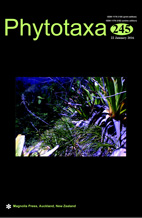Abstract
Two species of heterocytous cyanobacteria from the Mata Atlântica of Southeastern Brazil were studied intensively to determine if they were congeneric or belong to different genera. Additionally, their affinity to established genera in the Tolypothricaceae such as Tolypothrix Bornet & Flahault, Hassallia Bornet & Flahault and Spirirestis Flechtner & Johansen was investigated. Dapisostemon apicaliramis gen. et sp. nov. isolated from a wooden bridge in a mangrove swamp was found to be basal to a clade containing Tolypothricaceae, Nostocaceae, and Aphanizomenonaceae (but with weak support) by means of 16S rRNA gene sequence analyses. Moreover, D. apicaliramis had a 16S-23S ITS region similar in length, sequence, and secondary structure to the members of the terrestrial Tolypothricaceae. Streptostemon Sant’Anna et al. was placed in the Microchaetaceae (now the Tolypothricaceae) at the time of its description based on unsequenced natural material, but in this study it was found to be even more phylogenetically distant from that clade than Dapisostemon based on 16S rRNA gene sequence. It is in an unsupported and unresolved basal position in the Nostocales. It also presents a unique 16S-23S ITS region. The higher level evolutionary relationships of both genera are uncertain at this time, but neither genus can remain in the Microchaetaceae or Tolypothricaceae as the Nostocales undergo future revision. We conclude that Dapisostemon is sufficiently unique and separate that it requires a new family, the Dapisostemonaceae. This study further demonstrates that the cyanobacteria of tropical regions often represent novel taxa in unstudied lineages and that the study of tropical cyanobacteria will yield new insights in the biodiversity of this ecologically important group of photosynthetic microorganisms.

